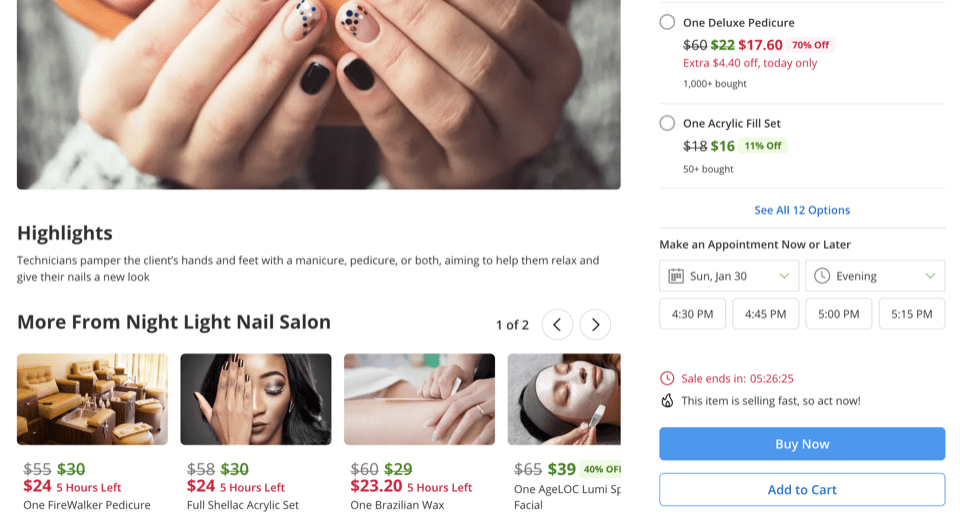Writing a blog, product page, or holiday landing page is all about managing your content. But how do you wrap up this content in a neat bow that will appeal to your customers and direct them towards more content? A strong call to action is your answer to effective marketing. A call to action (CTA, as it’s commonly referred to) is a marketing device that is essential to help sell your ideas. As the name would suggest, the purpose of a call to action is to prompt an immediate response from the reader. This prompt can be to sign up for a newsletter, contact the company for more information, or to buy a certain product. The important aspect of these prompts is that they keep the reader’s attention focused on you and your brand.
A well-designed and accessible website helps to direct its users towards a product, and a CTA is one of those guideposts helping to push users in the right direction. When learning about marketing, a call to action is inevitably part of the process. When you want to sell a product or promote your ideas online, you need a call to action to give your words that punchy impact to carry your readers towards becoming loyal customers/consumers. But how do you do that? You don’t want to have a generic write-up, you need something that really draws their attention, not simply from shock or profound prose, but from a connection with the product or the service you want to provide them with. That’s what we’ll explore below.
Defining A Call-to-Action
A call to action is a prompt, usually, at the end of a web page that incentivizes the reader to either buy a product or subscribe to an idea of yours. Using an imperative verb (such as, “call now” or “learn more today”) at the end of your page has a persuasive element to it, because the rest of your page’s content—up to that moment—is building up logical reasons why they should purchase your product or avail of your service.
Your website’s users need to be directed, or persuaded, towards an objective, and while this is crucial, there needs to be an added layer of subtlety. Nobody wants to feel as though they’re being sold something. When you use visual ‘signposts’, such as a link to purchasing a product, signing them up for a newsletter, or some other desired action, it shuttles your users in the right direction. But, it’s not as easy as writing “BUY NOW” and sending off your web page. The average click-through rate of CTAs is only 4.23% percent. Generic CTAs can be cliche, dull, and remind your readers that you are trying to sell them something. Luckily, below we’ll explain how you can create unique CTAs that intrigue the wariest of readers.
What To Know Before Writing a CTA

Before you even think about writing a CTA though, you need to have a few things sorted out. Having an outline is crucial because not only will it help you learn more about your business’s goals, but it will make the whole writing process easier. Marketing and writing calls to action are about an awareness of who your products are targeting and why you are targeting them:
What is your Goal?
Are you trying to sell a product? Get people to sign up for a newsletter? Or just generate more traffic for your site? A proper CTA can’t be a vague suggestion to the reader. It won’t catch their attention, and they will simply gaze over the words and not feel the impact of the command, or it will turn them off and they’ll feel insulted. You need to make sure they know exactly what they should do, or else there’s no strength behind your words.
Who is Your Audience?
Knowing your audience will help find your reasoning behind why you are selling them this product. Why do they need it in their life? This question is key to marketing, and a call to action is just an extension of this persuasion. Selling a product or an idea is not simply about what a person could have in their life (that they’re currently missing): it’s about helping them arrive at the conclusion that they should have this something in their life, and the absence of it is not just apparent, it’s noticeable.
Use Commanding Language
When it comes to promoting your ideas, your users respond positively to language that sounds confident. Remember, in relation to your customers, you are the one with the product, not them. They are the ones who need to realize that they have needed this something in their lives this whole time. Marketing your call to action is about wrapping up the realization that they needed this product. Up to that point, your page is informing your customers of all these reasons they need a product, by the time you bring up the CTA, they should be persuaded already to buy or subscribe. Keep this in mind! As a business owner, you need to constantly remind yourself that your reader wants to be persuaded and they want to trust you. They want to have a reason to purchase a product that promises to make their lives more meaningful (or at the very least, a little easier).
Your call to action is a marketing launchpad. You are selling a product/idea, be direct with your customers (but not rude). The prompt is the jumping-off point from that web page to another part of your website, and there should be no reason that your customers aren’t aware of that.
Make Your Button Text Inviting
The button text is the actual visualization of your call to action, the thing your readers will come across when they are browsing your website. It’s a key component to the user’s experience, and like all forms of design, it can help you get better conversion rates, and getting better conversion rates is crucial for any successful ecommerce business. Marketing your call to action is part of that design. Make sure it is visually pleasing, but don’t make it look jarring when compared to the rest of the page. While it should stand out, make sure it’s cohesive and is part of the general design of your website.
As mentioned before, no one likes to feel as though they are being sold a product. If you are selling a product, but you don’t want your customers to feel as though they are being forced to sign up. Instead, it should be interpreted as a suggestion. The language does need to be strong, but not demanding. Marketing your call to action as though they were the ones who realized they should buy your product, and not as though you are shoving your button text in their face. Instead of saying something like “Submit”, try something along the lines of “Learn More!”
Don’t Talk Down The Users
Speaking of kindness, you need to recognize your customers with the respect they deserve. You don’t want your CTA to make your users feel bad. Never use phrases like, “You’ll regret not purchasing this today,” it will only bring them down, rather than making them excited to purchase said product. Marketing the call to action should be about the positive, and not the negative. They’ll not only leave your website in a bad mood and they might begin to associate your website with negative feelings, which will only keep potential customers away from your site.
Instead of insulting your customers, talk about the merit of the product. Refer back to your outline on what is your goal and who is your product for. What about this product will help your customers with a fulfilling experience?
Recognize Your Value
Your product or service’s fulfilling experience is a value your customers won’t find anywhere else. Your call to action symbolizes marketing by presenting the merit of your product in a simple but powerful prompt that your customers want. Capitalizing on the value of your product is crucial for any business, and your CTA is the prime opportunity to remind the reader of this value. They have to believe they are getting some value by signing up for your newsletter or buying your product. Not only do they need to believe in your service, but they should also be excited by your product. They are getting a unique experience, and you are the one that is delivering them this experience.
Doesn’t that sound exciting? It should! The marketing strength in a call to action is only as strong as the business owner’s enthusiasm.
Make it Natural
But you’re not trying to sell a scheme. Remember, you want to give your customers the respect they deserve. As always, the golden rule of “treat others the way you want to be treated” is applicable in any marketing scenario. Make your CTA natural. An effective CTA is one that fluidly blends with the rest of your writing; it shouldn’t stand out because a CTA that reads as a CTA is awkward and unappealing to readers, and reminds them that they are being sold a product or an idea.
Make sure it’s part of the bigger picture and not artificial. Marketing your call to action is about it being part of your web page’s persuasive ideas concerning why your customers need these products, and what type of positive experience they can get by purchasing your product. These types of personalized CTAs, ones that blend in with the rest of the webpage, do much better than generic CTAs. One statistic says that calls to action perform 202% better than basic CTAs. You can’t ignore such a staggering number.
Urgency

A strong CTA is one that motivates your users to act fast. You don’t want the customer to be stressed (never have negative concepts on your website), but you want them to be inclined to immediately jump from this web page to a page where they can sign up or purchase one of your products. Your call to action’s role in marketing is to simulate the urgency, that they can get this product ASAP, which will give your customers a rush of excitement and persuade them to purchase your product. Using words like “now” not only gives a sense of command but helps to emphasize urgency. Make sure to instill a sense of immediacy in your call to action, this is how you’ll get customers to act on the CTA.
Offer Something
Who doesn’t like free things? Using phrases like, “Free shipping,” or “Free sample” are great ways to get people interested. Marketing the call to action quite literally by including something for free not only helps your CTA but is the best way to bring people to your website, because the allure of something free is one of the best ways to draw somebody’s attention. 83% to 93% of leads that come from a website are gotten through the internal link and anchor text CTAs found in a blog post, and using the word “free” is the best way to capitalize on the CTA bringing people to your website.
Visual Appeal
When it comes to customizing your website and making sure it’s designed with your customers in mind, visual appeal is key to keeping your users happy. Marketing and your call to action have to be comforting for your users. Not only does your site need to be visually appealing (nothing too abrasive, inoffensive colors, good graphics) you need to make sure it’s modern. Having a visually appealing CTA will do wonders to attract more users. Using bright colors people are attracted to can help draw their attention. Keeping a site updated and appealing gives it an air of professionalism, which will make your customers far more inclined to follow your call to action. Marketing is about the appeal, and your customers find appeal in what is comforting.
Font
Another aspect of visual appeal is the font. You want your font to be similar to the rest of the page. If it’s going to be different, you don’t want it to stand out and look ugly, this will only turn off your customers. In general, it’s good to use a font like Arial or Merriweather that is visually simple but pleasing to the eye. Some fonts like Comic Sans can turn even the most professional of sites into something that resembles a high school presentation. Different fonts can give a garish contrast that turns off a potential customer. This doesn’t mean you can’t make your call to action stand out with the help of marketing savvy. If you want your CTA to stand out, use size and color instead while keeping a similar font to the rest of your website.
Clear and to the Point
The only good CTA is a direct CTA. Be honest, be upfront, be deliberate. Similar to this tip, a strong call to action has no space for fluff.
Selling Your Site

A strong call to action is part of giving your users what they want and making sure they don’t have to look to find what you are selling them. That is what good website design looks like; it helps to direct your users around your website. Marketing and the call to action are essential for your website, but if you feel as though you don’t have enough time on your hands (running a website is a full-time job in itself!) to help sell your site, there are plenty of amazing web design companies out there that are more than willing to help you along and show you how easy it is to write unique CTAs that will boost your conversion rates.

